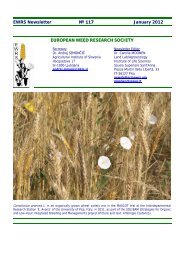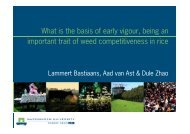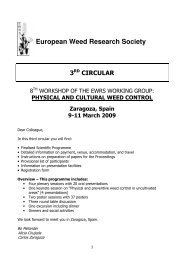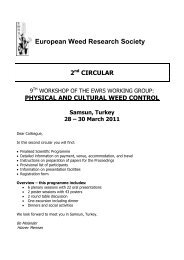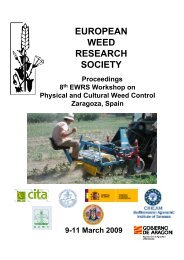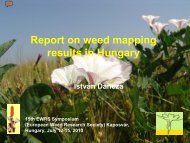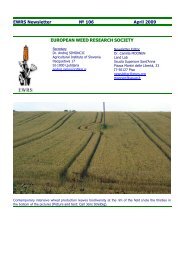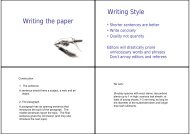Physical and Cultural Weed Control Working Group of - European ...
Physical and Cultural Weed Control Working Group of - European ...
Physical and Cultural Weed Control Working Group of - European ...
You also want an ePaper? Increase the reach of your titles
YUMPU automatically turns print PDFs into web optimized ePapers that Google loves.
9 th EWRS Workshop on <strong>Physical</strong> <strong>and</strong> <strong>Cultural</strong> <strong>Weed</strong> <strong>Control</strong> 20<br />
Samsun, Turkey, 28 – 30 March 2011<br />
What is the basis <strong>of</strong> early vigour, being an important trait <strong>of</strong> weed<br />
competitiveness in rice<br />
L. Bastiaans 1 , A. van Ast 1 <strong>and</strong> D.L. Zhao 2<br />
1 Wageningen University, P.O. Box 430, 6700 AK Wageningen, The Netherl<strong>and</strong>s E-mail:<br />
lammert.bastiaans@wur.nl<br />
2 International Rice Research Institute (IRRI), Manila, Philippines<br />
<strong>Cultural</strong> control is a promising alternative weed management strategy to help reduce the strong<br />
dependency on chemical weed control. One <strong>of</strong> the components <strong>of</strong> cultural control is the use <strong>of</strong><br />
cultivars with improved weed suppressive ability. The possibility to breed for an increased weed<br />
suppressive ability has been explored for a variety <strong>of</strong> crops. Repeatedly, early vigour, or the ability<br />
to grow relatively fast during early growth stages, has been identified as an important trait<br />
associated with the ability <strong>of</strong> the crop to better suppress weeds. Often times, screening for early<br />
vigour is based on a rather subjective visual score. In this study the aim was to find out whether<br />
early vigour in rice is based on specific traits or related to a particular growth strategy. In such case,<br />
it might be possible to define more objective <strong>and</strong> easy quantifiable traits for weed suppressive<br />
ability that would favour the screening <strong>and</strong> selection process.<br />
Field experiments with over forty rice cultivars were conducted to identify cultivars with<br />
superior weed suppressive ability. Based on these results, four rice cultivars were selected for<br />
further study in growth chambers. In these studies, regular plant sampling was used to determine<br />
initial growth <strong>and</strong> leaf area development <strong>of</strong> the cultivars throughout a four-week-period. These data<br />
were used as basis for a classical growth analysis. In addition, a simple plant growth model was<br />
used to establish the influence <strong>of</strong> growth strategy, characterized by assimilate allocation pattern, on<br />
early growth.<br />
The field experiments revealed that a visual vigour rating at 4 weeks after sowing was highly<br />
significantly correlated with weed suppressive ability (Zhao et al., 2006a,b,c). Further<br />
experimentation in growth chambers indicated that differences in total accumulated dry weight after<br />
26 days corresponded to the observed weed suppressive ability in the field. The two fastest growing<br />
cultivars had opposite growth strategies, with one cultivar investing in a high amount <strong>of</strong> leaf area<br />
<strong>and</strong> the other investing in high-quality leaves. Model simulations confirmed that differences in<br />
growth strategy not necessarily result in differences in overall growth rate. In the growth chamber<br />
experiments, differences in relative growth rate (RGR) between cultivars only became apparent<br />
after the first fourteen days. From that moment on the RGR <strong>of</strong> all cultivars dropped steadily, but this<br />
reduction in RGR was less strong in the more competitive cultivars. It was hypothesized that the<br />
reductions in RGR are a result <strong>of</strong> self-shading, <strong>and</strong> that the more competitive cultivars are better<br />
able to avoid self-shading, for instance through tillering. Whether the morphology <strong>of</strong> rice cultivars<br />
is indeed a more significant factor in the realization <strong>of</strong> early growth than initially assumed, is<br />
currently being investigated.<br />
References<br />
Zhao DL, Atlin GN, Bastiaans L & Spiertz JHJ (2006a) Cultivar <strong>Weed</strong>-Competitiveness in aerobic rice: heritability,<br />
correlated traits, <strong>and</strong> the potential for indirect selection in weed-free environments. Crop Science 46, 372-380.<br />
Zhao DL, Atlin GN, Bastiaans L & Spiertz JHJ (2006b) Developing selection protocols for weed competitiveness in<br />
aerobic rice. Field Crops Research 97, 272-285.<br />
Zhao DL, Atlin GN, Bastiaans L & Spiertz JHJ (2006c) Comparing rice germplasm groups for growth, grain yield <strong>and</strong><br />
weed-suppressive ability under aerobic soil conditions. <strong>Weed</strong> Research 46, 444-452.



